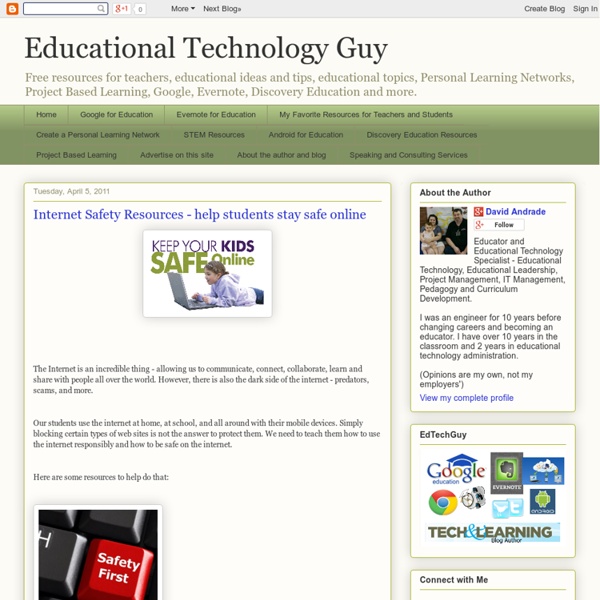Internet Safety Resources - help students stay safe online
The Internet is an incredible thing - allowing us to communicate, connect, collaborate, learn and share with people all over the world. However, there is also the dark side of the internet - predators, scams, and more.Our students use the internet at home, at school, and all around with their mobile devices. Simply blocking certain types of web sites is not the answer to protect them. We need to teach them how to use the internet responsibly and how to be safe on the internet.Here are some resources to help do that: Make Use Of - 6 Internet Safety Games To Help Kids Become Cyber Smart Make Use Of, a great resource in itself, has listed 6 online safety games that help kids learn how to be safe and smart online. These games are a great way to teach kids about internet safety.
6 Internet Safety Games To Help Kids Become Cyber Smart
With the age of cyber savvy kids on the rise, internet safety is just as important a part of education. Parents can play a prime role as educators. But then, there are loads of resources which can play the role of motivators. A class on internet safety need not be dull and drag when you have interactive games like these six to take you through the concepts. Webonauts Internet Academy This cool online game teaches kids all about the rules of web safety and digital citizenship. Safety Land The game is courtesy AT&T. Internet Safety Hangman This is a case of the classic Hangman game reincarnated as an internet safety educational game. Iggey and Rasper’s Internet Safety Game The Kids.com Jr. internet safety game for kids is a series of questions on net etiquette for kids. Anti-Phishing Phil This game is a limited version game of the actual one but the game play is enough to educate someone about phishing on the internet. OnGuard Online Image Credit: Shutterstock
Family safety basics – Getting started – For families – Safety Center – Google
Set a filter to keep inappropriate content out If you’d prefer to not to see mature or age-restricted content as you browse YouTube, scroll to the bottom of any YouTube page and enable Safety Mode. Safety Mode helps filter out potentially objectionable content from search, related videos, playlists, shows, and films. Learn more Scroll to the bottom of any YouTube page and click the drop-down menu in the “Safety” section. Select the On or Off option to enable or disable Safety Mode. To lock this setting, sign in to your Google Account. Once you're signed in, you will have the option to lock this setting.
Using online role play to teach internet safety awareness
a Graduate School of Education, University of Bristol, 35 Berkeley Square, Bristol BS8 1JA, UKb Department of Information Science, Loughborough University, Loughborough LE11 3TU, UKc Childnet International, Studio 14 Brockley Cross Business Centre, 96 Endwell Road, London SE4 2PD, UK Available online 5 April 2005 Choose an option to locate/access this article: Check if you have access through your login credentials or your institution Check access doi:10.1016/j.compedu.2005.03.003 Get rights and content Abstract This paper reports on an evaluation of Net-Detectives, a creative online role play activity aimed at 9–12 year olds. All sources of data collected agreed that a number of benefits arise from participation in the Net-Detectives online role play. However, the role of the ‘hosts’ in preparing participants and in moderating their communication is key to the success of the online role play. Keywords Interactive learning environments; Teaching/learning strategies; Secondary education
Related:
Related:




Andrade, David. "Internet Safety Resources - help students stay safe online." Educational Technology Guy. April 5, 2011. Blog. by taylorholen Jan 21